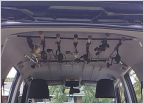-
Welcome to 4Runners.com!
You are currently viewing as a guest! To get full-access, you need to register for a FREE account.
As a registered member, you’ll be able to:- Participate in all 4Runner discussion topics
- Transfer over your build thread from a different forum to this one
- Communicate privately with other 4Runner owners from around the world
- Post your own photos in our Members Gallery
- Access all special features of the site
All gen review
Discussion in 'General 4Runner Talk' started by SlvrSlug, Dec 5, 2020.


 Need ‘03 4Runner blinker bulb help…
Need ‘03 4Runner blinker bulb help… Sleeping in 5th gen 4Runner...
Sleeping in 5th gen 4Runner... Dog Gear w/ Pics & Links
Dog Gear w/ Pics & Links Sealing holes in roof
Sealing holes in roof Need torque wrench, skid, recovery rope, etc...
Need torque wrench, skid, recovery rope, etc... Cabin Air Filters
Cabin Air Filters















































































